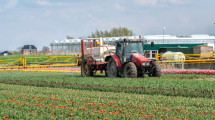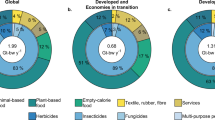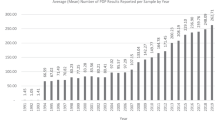Abstract
Numerous pesticide policies have been introduced to mitigate the risks of pesticide use, but most have not been successful in reaching usage reduction goals. Here, we name key challenges for the reduction of environmental and health risks from agricultural pesticide use and develop a framework for improving current policies. We demonstrate the need for policies to encompass all actors in the food value chain. By adopting a multi-disciplinary approach, we suggest ten key steps to achieve a reduction in pesticide risks. We highlight how new technologies and regulatory frameworks can be implemented and aligned with all actors in food value chains. Finally, we discuss major trade-offs and areas of tension with other agricultural policy goals and propose a holistic approach to advancing pesticide policies.
This is a preview of subscription content, access via your institution
Access options
Access Nature and 54 other Nature Portfolio journals
Get Nature+, our best-value online-access subscription
$29.99 / 30 days
cancel any time
Subscribe to this journal
Receive 12 digital issues and online access to articles
$119.00 per year
only $9.92 per issue
Buy this article
- Purchase on Springer Link
- Instant access to full article PDF
Prices may be subject to local taxes which are calculated during checkout


Similar content being viewed by others
References
Savary, S. et al. The global burden of pathogens and pests on major food crops. Nat. Ecol. Evol. 3, 430–439 (2019).
Larsen, A. E., Gaines, S. D. & Deschênes, O. Agricultural pesticide use and adverse birth outcomes in the San Joaquin Valley of California. Nat. Commun. 8, 302 (2017).
Niggli, U. et al. Pflanzenschutz und Biodiversität in Agrarökosystemen (Wissenschaftlicher Beirats des Nationalen Aktionsplans Pflanzenschutz beim Bundesministerium für Ernährung und Landwirtschaft, 2019).
Stehle, S. & Schulz, R. Agricultural insecticides threaten surface waters at the global scale. Proc. Natl Acad. Sci. USA 112, 5750–5755 (2015).
Lai, W. Pesticide use and health outcomes: Evidence from agricultural water pollution in China. J. Environ. Econ. Manag. 86, 93–120 (2017).
Lefebvre, M., Langrell, S. R. H. & Gomez-y-Paloma, S. Incentives and policies for integrated pest management in Europe: a review. Agron. Sustain. Dev. 35, 27–45 (2014).
Osteen, C. D. & Fernandez-Cornejo, J. Economic and policy issues of U.S. agricultural pesticide use trends. Pest Manag. Sci. 69, 1001–1025 (2013).
Swinnen, J. Economics and politics of food standards, trade, and development. Agric. Econ. 47, 7–19 (2016).
Nimenya, N., Ndimira, P. F. & de Frahan, B. H. Tariff equivalents of nontariff measures: The case of European horticultural and fish imports from African countries. Agric. Econ. 43, 635–653 (2012).
Handford, C. E., Elliott, C. T. & Campbell, K. A review of the global pesticide legislation and the scale of challenge in reaching the global harmonization of food safety standards. Integr. Environ. Assess. Manag. 11, 525–536 (2015).
Topping, C., Aldrich, A. & Berny, P. Overhaul environmental risk assessment for pesticides. Science 367, 360–363 (2020).
Kudsk, P. & Mathiassen, S. K. Pesticide regulation in the European Union and the glyphosate controversy. Weed Sci. 68, 214–222 (2020).
Special Report 05/2020: Sustainable Use of Plant Protection Products: Limited Progress in Measuring and Reducing Risks (European Court of Auditors, 2020).
Pesticide Sales (European Environmental Agency, 2019); https://go.nature.com/31pffJF
Hossard, L., Guichard, L., Pelosi, C. & Makowski, D. Lack of evidence for a decrease in synthetic pesticide use on the main arable crops in France. Sci. Total Environ. 575, 152–161 (2017).
Spycher, S. et al. Pesticide risks in small streams—how to get as close as possible to the stress imposed on aquatic organisms. Environ. Sci. Technol. 52, 4526–4535 (2018).
Special Eurobarometer 440: Europeans, Agriculture and the CAP (European Commission, 2016).
Huber, R. & Finger, R. Popular initiatives increasingly stimulate agricultural policy in Switzerland. EuroChoices 18, 38–39 (2019).
Maxwell, S. L. et al. Being smart about SMART environmental targets. Science 347, 1075–1076 (2015).
DG Health and Food Safety Overview Report: Sustainable Use of Pesticides (European Union, 2017).
Möhring, N., Gaba, S. & Finger, R. Quantity based indicators fail to identify extreme pesticide risks. Sci. Total Environ. 646, 503–523 (2019).
Saini, R. K., Bagri, L. P. & Bajpai, A. K. in New Pesticides and Soil Sensors 519–559 (Elsevier, 2017).
Rösch, A., Beck, B., Hollender, J. & Singer, H. Picogram per liter quantification of pyrethroid and organophosphate insecticides in surface waters: a result of large enrichment with liquid–liquid extraction and gas chromatography coupled to mass spectrometry using atmospheric pressure chemical ionization. Anal. Bioanal. Chem. 411, 3151–3164 (2019).
Kudsk, P., Jørgensen, L. N. & Ørum, J. E. Pesticide load—A new Danish pesticide risk indicator with multiple applications. Land Use Policy 70, 384–393 (2018).
Butler, D. EU expected to vote on pesticide ban after major scientific review. Nature 555, 150–151 (2018).
Böcker, T., Möhring, N. & Finger, R. Herbicide free agriculture? A bio-economic modelling application to Swiss wheat production. Agric. Syst. 173, 378–392 (2019).
Möhring, N., Dalhaus, T., Enjolras, G. & Finger, R. Crop insurance and pesticide use in European agriculture. Agric. Syst. 184, 102902 (2020).
Pe’er, G. et al. A greener path for the EU Common Agricultural Policy. Science 365, 449–451 (2019).
Pretty, J. Intensification for redesigned and sustainable agricultural systems. Science 362, eaav0294 (2018).
Schomers, S. & Matzdorf, B. Payments for ecosystem services: A review and comparison of developing and industrialized countries. Ecosyst. Serv. 6, 16–30 (2013).
Finger, R. Take a holistic view when making pesticide policies stricter. Nature 556, 174–174 (2018).
Waterfield, G. & Zilberman, D. Pest management in food systems: An economic perspective. Annu. Rev. Env. Resour. 37, 223–245 (2012).
Horowitz, J. K. & Lichtenberg, E. Risk-reducing and risk-increasing effects of pesticides. J. Agric. Econ. 45, 82–89 (1994).
Möhring, N., Bozzola, M., Hirsch, S. & Finger, R. Are pesticides risk decreasing? The relevance of pesticide indicator choice in empirical analysis. Agric. Econ. 51, 429–444 (2020).
Dessart, F. J., Barreiro-Hurlé, J. & van Bavel, R. Behavioural factors affecting the adoption of sustainable farming practices: a policy-oriented review. Eur. Rev. Agric. Econ. 46, 417–471 (2019).
Perry, E. D., Hennessy, D. A. & Moschini, G. Product concentration and usage: Behavioral effects in the glyphosate market. J. Econ. Behav. Organ. 158, 543–559 (2019).
Iyer, P., Bozzola, M., Hirsch, S., Meraner, M. & Finger, R. Measuring farmer risk preferences in Europe: A systematic review. J. Agric. Econ. 71, 3–26 (2019).
Möhring, N., Wuepper, D., Musa, T. & Finger, R. Why farmers deviate from recommended pesticide timing: The role of uncertainty and information. Pest Manag. Sci. 76, 2787–2798 (2020).
Finger, R., Möhring, N., Dalhaus, T. & Böcker, T. Revisiting pesticide taxation schemes. Ecol. Econ. 134, 263–266 (2017).
Siegrist, M. & Bearth, A. Chemophobia in Europe and reasons for biased risk perceptions. Nat. Chem. 11, 1071–1072 (2019).
Saleh, R., Bearth, A. & Siegrist, M. “Chemophobia” today: Consumers’ knowledge and perceptions of chemicals. Risk Anal. 39, 2668–2682 (2019).
Bearth, A., Saleh, R. & Siegrist, M. Lay-people’s knowledge about toxicology and its principles in eight European countries. Food Chem. Toxicol. 131, 110560 (2019).
Kraus, N., Malmfors, T. & Slovic, P. Intuitive toxicology: Expert and lay judgments of chemical risks. Risk Anal. 12, 215–232 (1992).
Bazoche, P. et al. Willingness to pay for pesticide reduction in the EU: nothing but organic? Eur. Rev. Agric. Econ. 41, 87–109 (2013).
Hartmann, C., Hieke, S., Taper, C. & Siegrist, M. European consumer healthiness evaluation of ‘Free-from’ labelled food products. Food Qual. Prefer. 68, 377–388 (2018).
List of Candidates for Substitution (European Commission, 2015); https://ec.europa.eu/food/plant/pesticides/approval_active_substances_en.
Kraehmer, H. et al. Herbicides as weed control agents: State of the art: II. Recent achievements. Plant Physiol. 166, 1132–1148 (2014).
Storck, V., Karpouzas, D. G. & Martin-Laurent, F. Towards a better pesticide policy for the European Union. Sci. Total Environ. 575, 1027–1033 (2017).
Milner, A. M. & Boyd, I. L. Toward pesticidovigilance. Science 357, 1232–1234 (2017).
Rosenbom, A. E. et al. The Danish Pesticide Leaching Assessment Programme: Monitoring results May 1999–June 2009 (Geological Survey of Denmark and Greenland, 2010).
Décret no 2016–1595 (La République Français, 2016); https://www.legifrance.gouv.fr/eli/decret/2016/11/24/AGRG1517899D/jo/texte.
Muller, A. et al. Strategies for feeding the world more sustainably with organic agriculture. Nat. Commun. 8, 1290 (2017).
Tschumi, M., Albrecht, M., Entling, M. H. & Jacot, K. High effectiveness of tailored flower strips in reducing pests and crop plant damage. Proc. Roy. Soc. B: Biol. Sci. 282, 20151369 (2015).
Lechenet, M., Dessaint, F., Py, G., Makowski, D. & Munier-Jolain, N. Reducing pesticide use while preserving crop productivity and profitability on arable farms. Nat. Plants 3, 17008 (2017).
Hickey, L. T. et al. Breeding crops to feed 10 billion. Nat. Biotechnol. 37, 744–754 (2019).
Chakraborty, S. & Newton, A. C. Climate change, plant diseases and food security: an overview. Plant Pathol. 60, 2–14 (2011).
Deutsch, C. A. et al. Increase in crop losses to insect pests in a warming climate. Science 361, 916–919 (2018).
Chen, K., Wang, Y., Zhang, R., Zhang, H. & Gao, C. CRISPR/Cas genome editing and precision plant breeding in agriculture. Annu. Rev. Plant Biol. 70, 667–697 (2019).
Zsögön, A. et al. De novo domestication of wild tomato using genome editing. Nat. Biotechnol. 36, 1211–1216 (2018).
Oliva, R. et al. Broad-spectrum resistance to bacterial blight in rice using genome editing. Nat. Biotechnol. 37, 1344–1350 (2019).
Metz, F. & Ingold, K. Politics of the precautionary principle: assessing actors’ preferences in water protection policy. Policy Sci. 50, 721–743 (2017).
Ramessar, K., Capell, T., Twyman, R. M. & Christou, P. Going to ridiculous lengths—European coexistence regulations for GM crops. Nature Biotechnol. 28, 133–136 (2010).
Qaim, M. The economics of genetically modified crops. Annu. Rev. Resour. Econ. 1, 665–694 (2009).
Smyth, S. J. The human health benefits from GM crops. Plant Biotechnol. J. 18, 887–888 (2019).
Mascher, M. et al. Genebank genomics bridges the gap between the conservation of crop diversity and plant breeding. Nat. Genet. 51, 1076–1081 (2019).
Towards a Scientifically Justified, Differentiated Regulation of Genome Edited Plants in the EU (Nationale Akademie der Wissenschaften Leopoldina, 2019).
Ledford, H. CRISPR conundrum: Strict European court ruling leaves food-testing labs without a plan. Nature 572, 15 (2019).
Walter, A., Finger, R., Huber, R. & Buchmann, N. Opinion: Smart farming is key to developing sustainable agriculture. Proc. Natl Acad. Sci. USA 114, 6148–6150 (2017).
Mahlein, A. K., Kuska, M. T., Behmann, J., Polder, G. & Walter, A. Hyperspectral sensors and imaging technologies in phytopathology: State of the art. Annu. Rev. Phytopathol. 56, 535–558 (2018).
Finger, R., Swinton, S. M., El Benni, N. & Walter, A. Precision farming at the nexus of agricultural production and the environment. Annu. Rev. Resour. Econ. 11, 313–335 (2019).
Metz, F. & Ingold, K. Sustainable wastewater management: Is it possible to regulate micropollution in the future by learning from the past? A policy analysis. Sustainability 6, 1992–2012 (2014).
Schaffrin, A., Sewerin, S. & Seubert, S. Toward a comparative measure of climate policy output. Policy Stud. J. 43, 257–282 (2015).
Peters, B. G. & Hoornbeek, J. A. in Designing Government: From Instruments to Governance (eds Eliadis, P. et al.) 77–105 (McGill-Queen’s University Press, 2005).
Ingold, K., Driessen, P. P. J., Runhaar, H. A. C. & Widmer, A. On the necessity of connectivity: linking key characteristics of environmental problems with governance modes. J. Environ. Plan. Manag. 62, 1821–1844 (2018).
Early, R. et al. Global threats from invasive alien species in the twenty-first century and national response capacities. Nat. Commun. 7, 12485 (2016).
Haasnoot, M., Kwakkel, J. H., Walker, W. E. & ter Maat, J. Dynamic adaptive policy pathways: A method for crafting robust decisions for a deeply uncertain world. Glob. Environ. Change 23, 485–498 (2013).
De Schutter, O., Jacobs, N. & Clément, C. A ‘Common Food Policy’ for Europe: How governance reforms can spark a shift to healthy diets and sustainable food systems. Food Policy https://doi.org/10.1016/j.foodpol.2020.101849 (2020).
Lee, R., den Uyl, R. & Runhaar, H. Assessment of policy instruments for pesticide use reduction in Europe; Learning from a systematic literature review. Crop Prot. 126, 104929 (2019).
Acknowledgements
We thank the research team of the Sinergia project CRSII5_193762 Evidence-based Transformation of Pesticide Governance, funded by the Swiss National Science Foundation, for conceptual support and intellectual inspiration. F.M.-L. was supported by the ANR project DECISIVE — Tracking degradation of soil pollutants with multi-elemental compound-specific isotope analysis (grant no. ANR-18-CE04-0004-02).
Author information
Authors and Affiliations
Contributions
N.M. and R.F. conceived of and led the manuscript writing and editing. The final manuscript was based on written input from all authors. All authors carefully revised the manuscript and approved the submission.
Corresponding authors
Ethics declarations
Competing interests
The authors declare no competing interests.
Additional information
Publisher’s note Springer Nature remains neutral with regard to jurisdictional claims in published maps and institutional affiliations.
Rights and permissions
About this article
Cite this article
Möhring, N., Ingold, K., Kudsk, P. et al. Pathways for advancing pesticide policies. Nat Food 1, 535–540 (2020). https://doi.org/10.1038/s43016-020-00141-4
Received:
Accepted:
Published:
Issue Date:
DOI: https://doi.org/10.1038/s43016-020-00141-4
This article is cited by
-
The effect of caraway oil-loaded bio-nanoemulsions on the growth and performance of barnyard grass and maize
Scientific Reports (2024)
-
The emergence of pesticide-free crop production systems in Europe
Nature Plants (2024)
-
Agricultural technology as a driver of sustainable intensification: insights from the diffusion and focus of patents
Agronomy for Sustainable Development (2024)
-
Bridging sustainability and effectiveness: assessing pesticide policies and regulation in Sri Lanka
Environment, Development and Sustainability (2024)
-
Reconfigurable self-assembly of photocatalytic magnetic microrobots for water purification
Nature Communications (2023)



